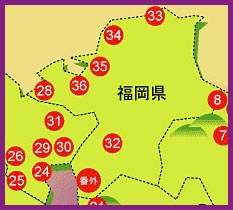. 九州三十六不動尊霊場 Kyushu - 36 Fudo temples .
:::::::::::::::::::::::::::::::::::::::::::::::::::::::::::::::::::::::::::::::::::::::::::::::::::::::
- Miyazaki 宮崎県
11 光明寺 萬寿不動 - Manju Fudo
12 長久寺 魔よけ不動 - Mayoke Fudo
13 潮満寺 波切り不動 - Namikiri Fudo
14 極楽寺 厄除不動 - Yakuyoke Fudo
Some Temples also belong to the Henro Pilgrimage.
This number is given in brackets (xx).

source : setokeiichiro.com
:::::::::::::::::::::::::::::::::::::::::::::::::::::::::::::::::::::::::::::::::::::::::::::::::::::::::::::::::::::::::::
Koomyooji 光明寺 Komyo-Ji
Nr. 11 (32) - 萬寿不動 - Manju Fudo

宮崎県延岡市古城町 / Furushiromachi, Nobeoka, Miyazaki
The temple had been built in 1181 on the 鬼門 "Demon Gate" side of the castle to protect it from evil influence.
Three main statues of Amida Sanzon 阿弥陀三尊
from the Nanboku period.
Other statues from 弘法大師 Kobo Daishi, 毘沙門天 Bishamonten
and 勝軍地蔵菩薩 Shogun Jizo Bosatsu.
In the compound is also a shrine for the deity
淡島大明神 Awashima Daimyoji
venerated for healing ladie's diseases.
. Awashima Jinja Shrine, 淡島堂 Wakayama .
The temple had been abolished in the Meiji restoration, but was allowed to rebuilt in 1880.
- - - - - Homepage of the temple
- source : daigo.ne.jp/temple
- There is a temple 萬寿寺 Manju-Ji with a Fudo statue in Saga.
:::::::::::::::::::::::::::::::::::::::::::::::::::::::::::::::::::::::::::::::::::::::::::::::::::::::::::::::::::::::::::
Chookyuuji 長久寺 Chokyu-Ji
Nr. 12 (38) 蓬莱山 Horaisan 長久寺
魔よけ不動 - Mayoke Fudo
宮崎県宮崎市大塚町城ノ下2825 / Jōnoshita Ōtsukachō, Miyazaki
The main statues are 六観音 Six Kannon.
- - - - - Homepage of the temple
- source : www.kyushyu88.com
- - - - - Yearly Festivals 年中行事
1月28日 不動護摩祈願会
3月21日(旧暦) 正御影供法要
5月28日 不動護摩祈願会
6月15日 青葉祭り(宗祖降誕会)
8月20日 施餓鬼法会
8月24日 供養灯籠流し
9月28日 不動護摩祈願会
12月22日(冬至) 星祭り祈願会
:::::::::::::::::::::::::::::::::::::::::::::::::::::::::::::::::::::::::::::::::::::::::::::::::::::::::::::::::::::::::::
Choomanji 潮満寺 Choman-Ji
Nr. 13 (39) 日南高野山 Nichinan Koyasan 潮満寺
厄除不動 - Yakuyoke Fudo
宮崎県日南市油津3-2-7 / 3 Chome-2-7 Aburatsu, Nichinan-shi, Miyazaki
- - - - - Homepage of the temple
- source : www.kyushyu88.com
- - - - - Yearly Festivals 年中行事
1月28日 不動護摩祈願会
3月21日(旧暦) 正御影供法要
5月28日 不動護摩祈願会
6月15日 青葉祭り(宗祖降誕会)
8月20日 施餓鬼法会
8月24日 供養灯籠流し
9月28日 不動護摩祈願会
12月22日(冬至) 星祭り祈願会
:::::::::::::::::::::::::::::::::::::::::::::::::::::::::::::::::::::::::::::::::::::::::::::::::::::::::::::::::::::::::::
Gokurakuji 極楽寺 Gokuraku-Ji
Nr. 14 大田井山 - 極楽寺
厄除不動 - Yakuyoke Fudo

宮崎県串間市北方5472 / 5472 Kitakata, Kushima-shi, Miyazaki
Founded in 1152 by 幸覚院一世.
It fell in despair, but was rebuilt in the Kamakura period by priest
Choojun 澄舜 Chojun.
It is closely related to the Shimazu family, especially 島津忠親 Shimazu Tadachika (1512 - 1571), who had it rebuilt in 1555 in order to help his people and protect the castle 飫肥城 Objjo.
There is a group of five-storied grave stone pagodas in the garden, memorial of the 島津家 Shimazu clan.
In 1831 the temple buildings were lost to fire and it was abolished in the Meiji period.
Since 1879 it had been re-built due to the deep faith of the local people.
The present 本堂 Hondo hall dates back to 1976.
.......................................................................

.......................................................................

shuin 朱印 stamp
- - - - - Homepage of the temple
- source : gokurakuji.blogspot.jp
.......................................................................
- - - - - Yearly Festivals 年中行事
5月 四国八十八ヶ所お遍路
Henro Pilgrims from Shikoku in May
- reference source : gokurakuji.blogspot.jp -
:::::::::::::::::::::::::::::::::::::::::::::::::::::::::::::::::::::::::::::::::::::::::::::::::::::::::::::::::::::::::::
- - - reference - coara.or.jp/~rinsaiji - 9 till 13 - - -
............................................................................
. 九州88ヶ所108霊場 Kyushu - 88 and 108 Henro temples .
. Pilgrimages to Fudo Temples 不動明王巡礼
Fudo Myo-O Junrei - Introduction .
:::::::::::::::::::::::::::::::::::::::::::::::::::::::::::::::::::::::::::::::::::::::::::::::::::::::::::::::::::::::::::
. Narita Fudo 成田不動尊 .
Temple Shinshooji 新勝寺 Shinsho-Ji
. O-Mamori お守り Amulets and talismans from Japan .
. Japanese Temples - ABC list - .
[ . BACK to WORLDKIGO . TOP . ]
[ . BACK to DARUMA MUSEUM TOP . ]
- #miyazakipilgrims #gokurakuji #chokyuji -
:::::::::::::::::::::::::::::::::::::::::::::::::::::::::::::::::::::::::::::::::::::::::::::::::::::::::::::::::::::::::::




















































